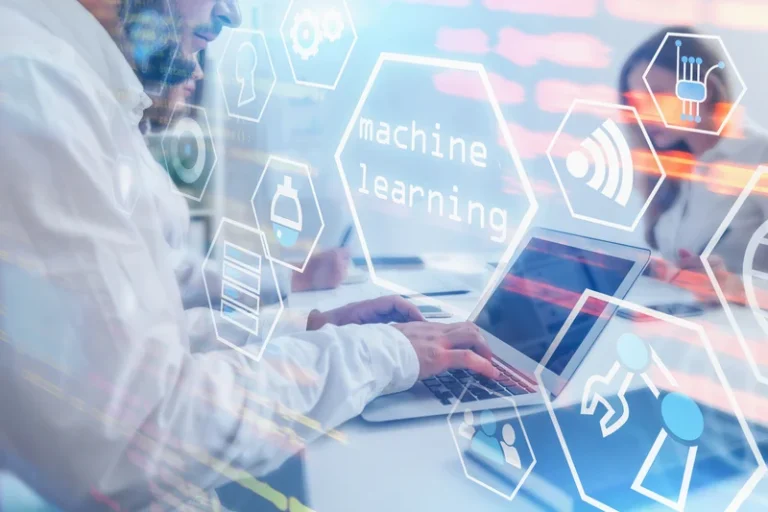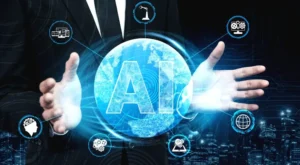How Does Machine Learning Work

Machine learning (ML) is a breathtaking branch of artificial intelligence (AI), and it is all around us. Machine learning unlocks the power of data in new ways, like Facebook suggesting articles in your feed. Such excellent technique helps computer systems learn and improve from experience by developing computer programs that automatically access data and perform tasks through predictions and detections. In this introduction to ML, we’ll talk about how does machine learning work.
What is machine learning?
Machine learning is a kind of artificial intelligence that allows software applications to predict outcomes without being explicitly programmed. When exposed to new data, these applications learn, go up, vary, and evolve by themselves. In other words, machine learning assumes that computers find helpful information without being told where to look. Instead, they use algorithms that learn from the data in an iterative process.
The concept of machine learning has been around for a long time (think of World War II Enigma Machine). Nevertheless, the idea of automating the application of complex mathematical calculations to extensive data has only been around for a few years, although it is now gaining momentum.
At the highest level, machine learning is the ability to adapt to new data independently and through iterations. Applications learn from past calculations and transactions and use “pattern recognition” to get reliable and valid results.

We are confident that we have what it takes to help you get your platform from the idea throughout design and development phases, all the way to successful deployment in a production environment!
Start working with machine learning
Machine learning completes learning from the data with specific machine inputs. It is crucial to understand how does machine learning work to use it effectively in the future.
The machine learning process begins with inputting training data into the chosen algorithm. To develop the final machine learning algorithm, you can use known or unknown data. The type of training input affects the algorithm, and this concept will be discussed next.
The new input data is passed to the machine learning algorithm to check if the algorithm works correctly. The prediction and results are then tested against each other.
If the prediction and results do not coincide, the algorithm is retrained several times until the data scientist gets the desired effect; this allows the machine learning algorithm to continually learn independently and produce an optimal answer that gradually improves accuracy.

Machine learning strategies
Traditional machine learning is often categorized by how the algorithm learns to make the most accurate predictions. There are four fundamental approaches: supervised learning, unsupervised learning, semi-supervised learning, and reinforcement learning. The type of algorithm data scientists choose depends on the data category they plan to predict.
Supervised learning
In this machine learning group, data scientists provide algorithms with labeled training data and define the variables they want the algorithm to evaluate for correlations. Both the input and the output of the algorithm are specified. Supervised learning algorithms are suitable for such tasks:
- Binary classification – the division of information into two groups.
- Multi-class classification – choose between more than two types of responses.
- Regression modeling – predicting continuous values.
- Ensemble – combining the predictions of several machine learning models to get an accurate forecast.
The most common methods used in supervised learning include neural networks, linear regression, logistic regression, etc.
Unsupervised learning
Such a type of machine learning involves algorithms that train on unlabeled data. The algorithm scans the databases looking for any significant relationship. The data on which algorithms are trained and the predictions or recommendations they make are predetermined. Unsupervised learning algorithms are suitable for the different tasks:
- Clustering: dividing a data set into categories based on a particular attribute.
- Anomaly detection: recognizing unusual data items in a database.
- Association mining: identifying sets of components in a dataset that often occur together.
- Dimensionality reduction – decreasing the number of variables in a data set.
Principal component analysis and singular value decomposition (SVD) are two common unsupervised learning approaches.
Semi-supervised learning
This approach to machine learning combines the elements of two preceding types. Semi-supervised learning works with data scientists who feed the algorithm a small amount of labeled training data. From here, the algorithm learns the sizes of the data set, which it can then apply to new, unlabeled data. The performance of algorithms usually increases if they are trained on labeled databases. However, data labeling can be time-consuming and costly. Some fields where semi-supervised learning is helpful to utilize:
- Machine translation teaches algorithms to translate language based on a complete dictionary of words.
- Fraud detection – detecting fraud cases when you have only a few examples.
- Data Labeling – algorithms trained on small datasets can automatically learn to apply data labels to large databases.
The most common semi-supervised learning methods are generative models, low-density separation, and laplacian regularization.
Reinforcement learning
Data scientists use reinforcement learning to train a machine to perform a multistep process with well-defined rules. Data scientists program an algorithm to perform a task and give it positive or negative signals when it decides how to complete the job. However, for the most part, the algorithm itself understands what steps to take along the way. Reinforcement learning is usually used in such spheres as:
- Robotics – teaching robots to perform tasks in the physical world.
- Video gaming – training bots to play games.
- Resource management – helping companies plan how to allocate resources.
This model learns on the go through trial and error.
Why is machine learning meaningful?
Machine learning is essential because it gives businesses insight into customer behavior trends and business models and supports new product development. Many modern leading companies, such as Facebook, Google, and Uber, make machine learning a prominent part of their operations. Machine learning has become an essential competitive advantage for many companies.
How businesses are using machine learning
Companies are already using machine learning in different ways, including:
- Recommendation algorithms: the recommendation engines that power Netflix and YouTube offerings, the information displayed in your Facebook feed, and product recommendations are powered by machine learning.
- Picture analysis and object detection: machine learning can analyze images for various information, such as learning to identify people and distinguish between them, although face recognition algorithms are inconsistent.
- Fraud detection. Machines can analyze patterns, such as how people usually spend money or where they typically shop, to detect potentially fraudulent credit card transactions, login attempts, or email spam.
- Automatic helplines or chatbots: many organizations are implementing online chatbots, in which customers don’t talk to live employees but instead interact with a machine. These algorithms use machine learning and natural language processing, with bots learning from past conversation recordings to give correct answers.
- Self-driving cars. Much of the technology behind self-driving vehicles relies on machine learning, specifically deep learning.
- Medical research and diagnostics. Machine learning programs can be trained to analyze medical images or other information and look for specific signs of illness, such as a tool that can predict cancer risk based on mammograms.
The list of uses for machine learning is constantly growing.
Challenges of machine learning
Machine learning professionals face many challenges in instilling machine learning skills and building an application from scratch, including:
- Poor quality of data: impure and noisy data can make the whole process extremely tedious. It’s necessary to remove outliers, filter missing values, and remove unwanted functions to solve the problem at the preparatory stage.
- Underfitting the training data occurs when the data cannot establish a real relationship between input and output variables because the data is too simple. You need to spend maximum time on training and increase the complexity of the models to avoid such difficulties.
- Slow implementation: machine learning models effectively provide accurate results, but it takes a considerable time. Additionally, constant monitoring and maintenance are required to achieve the best results.
It is important to remember that machine learning is a high-risk, high-return technology.

How to choose a correct machine learning model?
Choosing a suitable machine learning model to solve a problem can be time-consuming if you don’t think strategically.
Stage 1: Match the problem with potential inputs to consider when solving. At this stage, you need the help of data scientists and experts who deeply comprehend the issue.
Stage 2: Collect the data, format it, and label it if necessary. This step is usually performed by data scientists with the help of data wranglers.
Stage 3: Determine which algorithms to use and see how well they perform. This step is typically the responsibility of data scientists.
Stage 4: Continue fine-tuning the output until it reaches the desired level of accuracy. This step is performed by data scientists with the assistance of experts who have a deep understanding of the problem.
Creating a machine learning model is just like developing a product.
Top 3 machine learning tools
Machine learning algorithms provide applications with the ability to offer automation and artificial intelligence features. Below are the three leading machine learning software:
- scikit-learn is a machine learning library for the Python programming language that offers several supervised and unsupervised ML algorithms.
- Personalizer is a cloud service from Microsoft used to provide clients with a personalized and up-to-date experience. Utilizing reinforcement learning, this easy-to-use API helps to increase digital store conversions.
- The Google Cloud TPU is a Machine Learning Application-Specific Integrated Circuit (ASIC) designed to run machine learning models with AI services in the Google Cloud. It delivers over 100 petaflops of performance in just one module, enough for business and research needs.
Interestingly, most end users are not aware how does machine learning work in such intelligent applications.
Importance of human interpretation of machine learning
Explaining how a particular machine learning model works can be challenging if the model is complex. Data scientists have to use simple machine learning models in some vertical industries because it is crucial for the business to explain how each decision was made. It’s especially true in sectors with heavy compliance burdens, such as banking or insurance.
Complex models can make accurate predictions, but it is difficult to explain how the result was determined to the layman.
What are the perspectives of machine learning?
Although machine learning algorithms have been around for decades, they have gained new popularity due to the active development of artificial intelligence. In particular, deep learning models are the basis of today’s most advanced AI applications.
Machine learning platforms are one of the most competitive areas of enterprise technology. Nowadays, most big vendors like Amazon, Google, and others are chasing customer subscriptions to platform services that cover a range of machine learning activities, including data collection, data preparation, data classification, model creation, training, and application deployment.
As the importance of machine learning to business operations continues to grow, and as AI becomes more practical in enterprise settings, the competition between machine learning platforms will only intensify.
The ongoing research in deep learning and artificial intelligence is increasingly focused on developing more general applications. Modern AI models require rigorous training to create an algorithm optimized for a single task. But some researchers are exploring techniques to make models more flexible to allow a machine to apply the context learned during one task to other future missions.
Top Articles
How To Choose AI Software For Your Business?
I am here to help you!
Explore the possibility to hire a dedicated R&D team that helps your company to scale product development.






